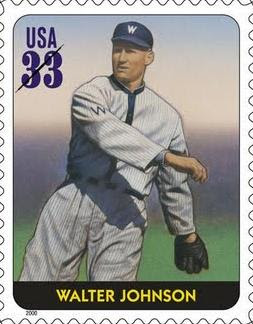
Tristram E. Speaker (April 4, 1888 - December 8, 1958), nicknamed "Spoke" and "The Grey Eagle", was an American baseball player. Considered one of the best offensive and defensive center fielders in the history of Major League Baseball, he compiled a career batting average of .345 (fourth all-time), and still holds the record of 792 career doubles. Defensively, his career records for assists, double plays, and unassisted double plays by an outfielder still stand as well. His fielding glove was known as the place "where triples go to die."
Speaker led the Boston Red Sox to two World Series championships, and then carried the Cleveland Indians, as player-manager, to that team's first-ever World Series title. His innovations, most notably the platoon system and the infield rotation play, revolutionized the game. He was inducted into the Baseball Hall of Fame in its second year of voting, 1937.
Tris Speaker was born on April 4, 1888 in Hubbard, Texas, to Archie and Nancy Poer Speaker. As a youth, he suffered a fractured right arm in a fall from a horse, forcing him to throw left-handed, which he continued to do throughout his baseball career. In 1905, Speaker played his only year of college baseball, for Fort Worth Polytechnic Institute. His left arm was severely injured in a football accident, to the extent that surgeons advised amputation. Tris refused, and fully recovered.

Speaker finally won the regular starting center fielder's job in 1909 from the light-hitting Denny Sullivan, who was then sold to the Cleveland Naps. Speaker hit .309 in 143 games as the team finished third in the pennant race.
In 1910 the Red Sox signed Duffy Lewis, who became the left fielder, and, with Speaker and Harry Hooper would form Boston’s “Million-Dollar Outfield”, one of the finest outfield trios in baseball history, playing together until Speaker was traded to the Cleveland Indians in 1916.
The Boston Red Sox finished second to Connie Mack’s Philadelphia A’s, who were led by their formidable pitching trio of Jack Coombs, Chief Bender and Eddie Plank, the following two years.
Speaker’s best season came in 1912, as he played every game, leading the American League in doubles with 53, and home runs with ten. He set career highs with 222 hits, 136 runs, 580 at-bats, and 52 steals, the latter a team record which would stand until Tommy Harper stole 54 bases in 1973. He batted .383, a mark he would surpass three times in his career, but his .567 slugging percentage was the highest of his dead-ball days. Speaker set a major league record when he had three batting streaks of twenty or more games (30, 23, and 22) during the season. The Red Sox won the pennant by finishing 14 games ahead of the Washington Senators and 15 games ahead of the Philadelphia A’s. In the 1912 World Series, Speaker led the Red Sox to their second World Series title over John McGraw's New York Giants, with the Red Sox winning the eighth and final game (game two was called on account of darkness and ended in a tie) after Fred Snodgrass's error—dropping an easy fly ball that would have been the first out—and Fred Merkle's blunder—failing to go after a Speaker pop foul that would have been the second out, after which Speaker promptly singled home the tying run—allowed the Red Sox to tie and win the game in the bottom of the tenth inning. Speaker hit .300 in the Series, with nine hits and four runs scored.

Records and achievementsMost
career doubles (792)
Most career outfield assists (449)
Fifth highest lifetime major-league batting average (.345)
Fifth in career hits
Sixth in career triples
Eighth in career runs
Led American League in batting 1 time
Led American League in slugging percentage 1 time
Led American League in on base percentage 4 times
Led American League in hits 1 time
Led American League in total bases 1 time
Led American League in doubles 8 times
Led American League in home runs 1 time
Led American League outfielders in putouts 7 times
Led American League outfielders in double plays 6 times
Led American League outfielders in assists 3 times
Led American League outfielders in fielding average 2 times
Batted over .380 five times
Struck out only 220 times in 10,195 at-bats (although his page at Tris Speaker statistics shows that records of strikeouts were not kept for the first six years of his career. Still, in the seasons in which records were kept, he never struck out more than 25 times).
In 1999, he ranked Number 27 on The Sporting News' list of the 100 Greatest Baseball Players, and was nominated as a finalist for the Major League Baseball All-Century Team.
All-time leader in HBWRL rings, with 10
First player of only two players ever (Craig Biggio in 1998) to reach 50 stolen bases and 50 doubles in a season in 1912.

















































